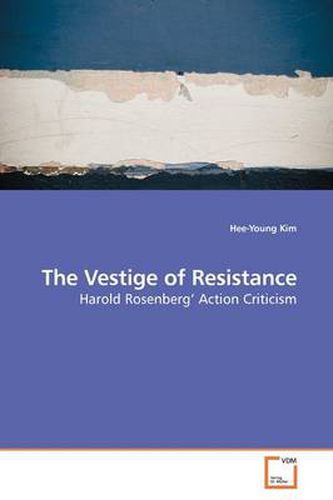Readings Newsletter
Become a Readings Member to make your shopping experience even easier.
Sign in or sign up for free!
You’re not far away from qualifying for FREE standard shipping within Australia
You’ve qualified for FREE standard shipping within Australia
The cart is loading…






This title is printed to order. This book may have been self-published. If so, we cannot guarantee the quality of the content. In the main most books will have gone through the editing process however some may not. We therefore suggest that you be aware of this before ordering this book. If in doubt check either the author or publisher’s details as we are unable to accept any returns unless they are faulty. Please contact us if you have any questions.
Harold Rosenberg (1906-1978) coined the term action painters to describe postwar American abstract painters. Since then his concept of action has been considered a supplementary term that reinforces autonomy in art. Reading against the grain, Kim proposes to situate Rosenberg’s practice in a domain where art lies beyond the rules of aesthetics. Believing in process, vestiges, and possibilities, Rosenberg perceived art to be a substantial component of culture. The meaning of an artwork is not set by aesthetic principles, but is contingent on its context. Providing no vision of completing a priori principles, this contingency is associated with a sense of crisis that generates a radical force for critical art practices. Rosenberg’s action epitomizes his central idea that the artist continues to transform him-or herself. This ceaseless discovery by the artist, for Rosenberg, is the content of the artwork. It is an eloquent statement that speaks to individual subjectivity after a collective revolution had failed. His criticism was a constant transaction, which kept modifying itself through his encounters with artists.
$9.00 standard shipping within Australia
FREE standard shipping within Australia for orders over $100.00
Express & International shipping calculated at checkout
This title is printed to order. This book may have been self-published. If so, we cannot guarantee the quality of the content. In the main most books will have gone through the editing process however some may not. We therefore suggest that you be aware of this before ordering this book. If in doubt check either the author or publisher’s details as we are unable to accept any returns unless they are faulty. Please contact us if you have any questions.
Harold Rosenberg (1906-1978) coined the term action painters to describe postwar American abstract painters. Since then his concept of action has been considered a supplementary term that reinforces autonomy in art. Reading against the grain, Kim proposes to situate Rosenberg’s practice in a domain where art lies beyond the rules of aesthetics. Believing in process, vestiges, and possibilities, Rosenberg perceived art to be a substantial component of culture. The meaning of an artwork is not set by aesthetic principles, but is contingent on its context. Providing no vision of completing a priori principles, this contingency is associated with a sense of crisis that generates a radical force for critical art practices. Rosenberg’s action epitomizes his central idea that the artist continues to transform him-or herself. This ceaseless discovery by the artist, for Rosenberg, is the content of the artwork. It is an eloquent statement that speaks to individual subjectivity after a collective revolution had failed. His criticism was a constant transaction, which kept modifying itself through his encounters with artists.